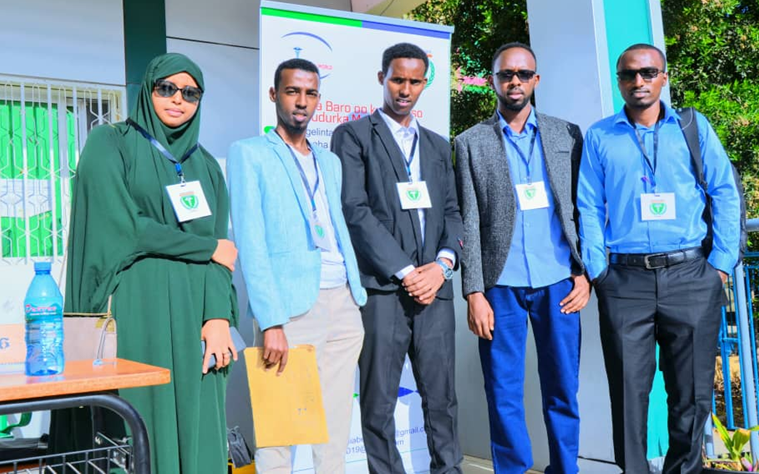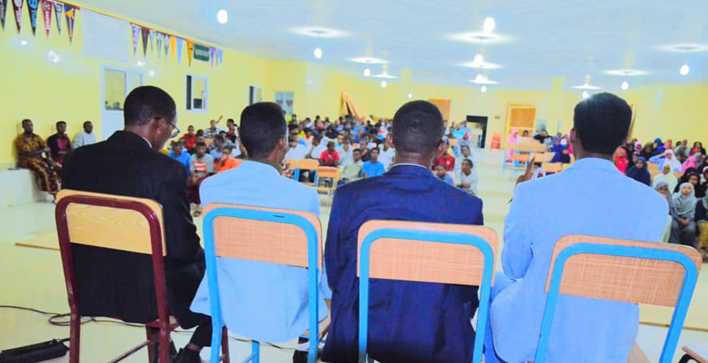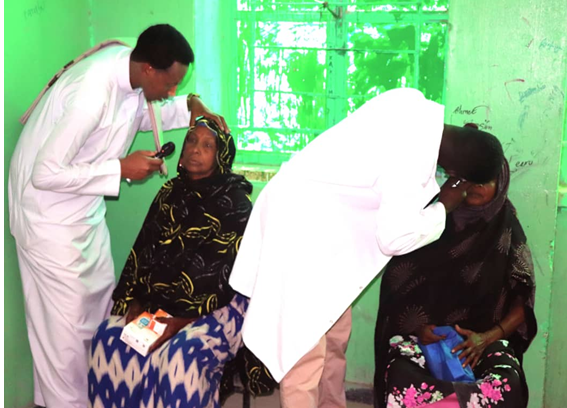
|

|
In March 2018, a friend of mine called me an unaccustomed time. He is sharing with me the grim news of his uncle’s death and wants me to participate in the obsequies. Together on the way, he told me that the death of his uncle is counting to a stroke resulted from the consequence of unknown diabetes.

It was the same week I encountered another friend in Hargeisa Group Hospital who is caring for his uncle admitted to the hospital for stroke. When I asked him back if his uncle has a known risk factor for the stroke, he retorted that his uncle was as fit as a fiddle before this condition but now the doctors said he is a diabetic. Within a week two patients died of complications of unknown diabetes!

It was the same year we have supposed to have our first duty in the medical rotation ward. In the new unfriendly hospital environment, our small ward containing less than 20 beds has large proportions of what they called Chronic Kidney Disease. One bed to another, five to six out of the fourteen patients present at that time. At the gate of the ward, when I asked a more senior student why does this happen? Striding away, not shocked by my frightening question, he simply responded maybe because of the chronic disease like diabetes and hypertension which are becoming common in our community.

Coming home with unanswerable questions spinning through the head, I hurled my handbag, suddenly open up my laptop, and visited the world web thirsty for more information on why diabetes becoming so prominent such small countries in which its people are manual workers mostly. I have had already basic knowledge of what diabetes is and how it affects the body in my basic medical courses, but what I want to know was the extent of the disease and its complications advent before recognizing whether it is a particular phenomenon inside the Somalis.
I opened three to four taps on the browser and went on straight to a WHO, World Medical Journal, PubMed, and WebMD. 2014 was WHO’s last diabetes update. Not needed, searched for more updated ones. Through the links, I found IDF, clicked, and came with a site that stills a close friend of mine whenever I needed updated information about diabetes.
212 million out of the 425 million diabetics are undiagnosed. Both heartwarming and heartrending! Heartwarming such that problem shared is a problem halved and heartrending such that many innocent patients are dying of diabetes. But the bitter news is that two-third of the diabetes are living in developing countries. It is unbearable pain that the countries dominated by infectious disease are now the major victims of non-communicable disease. A double burden, double burden which the health care of emerging countries cannot withstand.
That was the premises of what made Somali Diabetic World. A voluntary organization advocates Somalis without diabetes. A story led me to focus less on medical school and care more on public health issues. A story compelled me to join journalism class amid most tough medical classes to be legible to convey my message via the major media outlets.
As a medical student, where do I start? Do I urge my colleagues to participate in the commencement of the organization? How do I kick off an organization that can work beyond the first vigorous days of start? In my little experience of youth-led activities, which I closely involved in since high school, I have felt that every organization built on a basis of friendship and pain experienced by a particular individual, will not last long beyond its shade but dissipates as a fog in the next days of its inception. For that reason, I took a different approach to tackle the issue at hand. With the help of social media, I disseminated the idea so that everybody who felt the same pain as me will come out straight and the organization will end up with individuals who may not know each other physically but can associate spiritually.
Some form or shape, the idea had worked. Although we are still under construction, there are certain individuals, we did not know each other, but have their stories of diabetes infliction who had participated in Somali Diabetes World’s activities in the last three years and eager to be part and parcel of this activity. Now onward, I will use ‘we’ rather than “I” as the story goes beyond me.

What Do We Want?
It is simple and not so much. Same with other people, we want diabetic people to enjoy healthier, happier and prosperous life that has no basic daily life restrictions. We want nobody to be diabetic and those who had already live with it robustly. To reach that goal we settled on five major goals.
- Awareness
This is our diabetes journey gate and our area of work so far. We believe healthy information is a basic human right and the only community-equipped right information can reach legible decisions. Hence, we want the Somali community to have basic diabetes education so that they can take the right steps in diabetes prevention.
- Diabetes Research
Without research, effective goal targeted steps cannot be taken out. We cannot prioritize our work and we would not be able to reach a successful outcome in the nearby time. In this research, which is our next step forward, that will be conducted amid the awareness campaign in the next year, will be aimed at unveiling the number of diabetic patients living in the Somali Peninsula (Somaliland in the first phase), what they know their diabetes status, how they live with it and then how to orchestrate the combating efforts accordingly.
- Diabetes Registry and Bracelet Provision
Inside the community, diabetic people are get neglected because of a lack of acknowledgment and awareness. If a diabetic person collapsed in the street or downtown due to drop in blood sugar, no one is helping them because they cannot recognize his or her condition, and they may stride away teetering at the brink of death. To fill that abyss, we want to register diabetic persons and give them medical bracelet identification card written with vital information about the patient. We confidently believe in that simple affordable and accessible steps like bracelet ID could positively impact and save the lives of diabetes.
The diabetes registry would also enable us to create a diabetic community that can help and inspire each other by their story and experience.
- Early Diabetic Screening and Detection
If a person becomes diabetic, the odds are overwhelming not only for that patient but for the family and the state as a whole. One way that we can reduce that problem is to do screening and early diabetic detection. In this way, a lot of people who are living with diabetes unknowingly and many others who are prediabetics will be found out and urge to take the necessary precautions. We are targeting diabetic-prone people like those who have had a familial line of diabetes, obese, have diabetes during pregnancy, and aging people over forty-five years.
- Diabetes Health Center
As a community dominated by infectious diseases and health care professional scarcity, our health care centers do not arrange in a way suitably serve diabetic patients. Diabetic patients require a diabetic-friendly center where they can get not only medications but counseling, medication-diet adjustment education and a clearly delineated itinerary plan for follow-ups. A center where the medication, counseling, and diabetic tool are not a prerogative to rich people but everybody can get access to diabetes facilities without financial restrictions.
Somali Diabetic World’s Diabetes Health Center will be a place where all diabetic patients get all diabetic facilities in equity regardless of their economic status.
What Have We Done?
For three years we are working under the awareness article, we have achieved the following:
- Diabetes Health Awareness Campaign at Schools and Educations Centers
We shared diabetic basic health information with over six thousand high school students. We introduced the students to what diabetes is, how to prevent it, and how healthily live with it. Questions and answers we ended in each session gave us an image that the students get an idea about diabetes and come back with their homes with slight knowledge about diabetes which indirectly would impact their families and relatives.
Diabetes Health Awareness Campaign at Schools and Educations Centers, Abaarso School
Diabetes Health Awareness Campaign at Schools and Educations Centers, Noradin Schools
2;Offer Diabetic Equipment for Diabetic Needy People
Like the diet and medication, diabetic patients require diabetic basic tools included glucometers and test strips, to monitor their blood sugar levels on a daily basis. Many poor diabetic patients do not have these basic tools due to their meager income. This makes less effective the medication they get barely. To alleviate that hindrance, we organized a diabetic fundraising program entitled Offer Diabetic Equipment for the Diabetic Needy People, in which we want to distribute glucometers and test strips a diabetic disadvantaged people. We gathered fifty diabetic patients from one of the slum villages in Hargeisa and distributed glucometers and two months test strips.
Diabetic Equipment We Offered Diabetic Needy People
- Diabetes Education Pamphlet
Unlike many diabetic patients over the world, Somali diabetic patients have no diabetic written resource which they can review their diabetes status whenever they get stuck. Apart from that many diabetic Somalis are illiterate and cannot read and write, those who had the fortune to read have no accessible written Somali diabetic books to read. There is very dearth shambolic diabetic information on online and no written diabetic pamphlets at all. Similarly, the non-diabetic person who is exhausted and frightened the looming news of diabetic friends and family has nowhere to look at diabetes to take the necessary steps that he or she can prevent diabetes. Bearing that in mind, we wrote Baro oo is Baxnaani which loosely means Learn and Live with the Diabetes, which both diabetic and non-diabetic people can get all the fundamental information which a one is ought to know about diabetes. Unfortunately, for two years this book remained unpublished due to lack of sponsorship.
3. Diabetes Self-Management Program
Nothing is more worth a diabetic patient to understand how to tackle his condition confidently. When he or she needs medication, take a diet, make exercise, or come to the doctor for follow-up. A basic health education which most health professionals can provide improves the life of diabetic people and lessens the burden of a diabetic patient to health institutions. We introduced diabetes self-monitoring to fifty diabetic patients physically and recorded a clip instructing diabetic people how to do diabetes self-management at home.
Somali Diabetic World’s Volunteer’s Performing Self-Management Education
- Diabetes Patient Story
Traditional health-seeking behavior is still prevailing in a Somali health context. The community does not widely embrace modern scientific medicine. They are more accustomed to traditional healers than doctors. Diseases like diabetes; this is a catastrophe that needs to be tackled sooner rather than later. For instance, when many young patients get Diabetic Ketoacidosis, DKA, a life-threatening emergency diabetic medical condition, much diabetes ended up Cilaaj, a quasi-religious health center, rather than hospitals. Many of them come back from the Cilaaj when they are on the brink of death where a large proportion passed away before the hospital or at the hospital because they reached a terminal stage where the unsophisticated developing country health system cannot deal with.
To get rid of that superstition, we created a story of a young woman who whenever her diabetes gets serious their family scurried to a cilaaj for exorcism which aggravates her condition.
- Diabetes Television Health Show
One way we can reach an ample audience was to host a diabetic television health show, where we can convey diabetes health information to a wider community when they are comfortably propped up on their beds in less stressed time they can internally digest all that devoured up. We aired over ten episodes of different topics in diabetes each contributing a different doctor mostly in different specialties in the area of diabetes they are covering. The topics we covered included an overview of diabetes, prevention of diabetes, living with diabetes, diabetes and eye care, diabetes and kidney care, diabetes and heart care, diabetes and wounds (leg wounds), and diabetes and pregnancy, alongside diabetic patient story clips which a long-lived diabetic successful patient shared their stories other diabetic patients and the wider community to encourage and inspire each other.
- World Diabetes Day
Established officially in 2006 by WHO and IDF, World Diabetic Day is a global diabetes awareness day that encourages people to take steps against diabetes. In the last three years, 2018-2020, we have participated in that international activity and we held diabetes awareness in Somaliland, 2018 in Hargeisa, 2019 in Buro, Berbera, Borama, and Hargeisa, and 2020 on social media due to the COVID-19 restrictions. We performed free diabetes screening and events mainly. We were not able so far to do a standard global diabetes walk due to local issue restrictions where the diabetes awareness can reach further.
- Diabetes Eye Care
As stated International Diabetes Federation, diabetes is the leading cause of vision loss in working-age adults, people aging between 20 to 65 years. Without early detection and effective treatment, this threatens the patient’s sight. Hence, we mobilized thirty three diabetic disadvantaged people and made free diabetes eye screening session.
Our Doctors Doing Diabetes Eye Checking
During the three-year course of our work, we met unprecedented and unimaginable diabetic stories hidden inside the community. What we thinking of and what we encountered was different. On a working visit we paid to one of the slum villages in Hargeisa, where we were inquiring diabetic people indwelling in that village whether they have glucometers to monitor their blood sugar levels, over 50-year-old woman answered that she checks her blood sugar level once a week. That old lady explained the reason that she has no glucometer at home but on Thursdays, she walks around 10km for a far clinic which the doctor of that clinic provides free diabetes checks on Thursdays. A poor woman longing to care for herself but financial barriers precluded. Another infirm woman who has no diabetic medications we surmised she is having signs and symptoms of heart failure during our interview had passed away in the interim between the data collection and diabetes facility mobilization.
Similarly, as data we received from Mohamed Sheikh Dialysis Center affirmed, 20% of the patients admitted in 2018-2019 for dialysis were diabetics. Likewise, if you glance at the surgical ward, you will see a very large number of patients performing limb amputation. Diabetic hand ulcer, a nonhealing sore of the hand needed hand-removing as therapy resulted from diabetes, which is quite uncommon and written iota in medical textbooks is even popular in our operating wards. In one of our interviews, Dr. Mohamed Hawadle, one of the surgeons in HGH, mentioned that every operation day there is at least one diabetic patient who is cutting a leg or removing dead tissues (debridement) in his or her body.
What does this mean to us as a Somali Diabetic World? It shows us how diabetes deeply ingrained in the community. How it is spreading unknowingly. How big the disparity between the information people has and how it is affecting their lives, and at last, how far we must go if we are really inclined to cope with something in this calamity.
On the other hand, that three-year course of our work, there is one alarming positive thing. There is an early harbinger sign of public awakening. There are privately owned diabetic health clinics built in the last two years and other diabetic movements emerging from the community.
Let me conclude a personal viewpoint as I started. In my early years of medical school, I fathomed being solely a good doctor is not enough? If the system is broken and the populace uninformed, serving thirty patients in semi solitude closed rooms on in-dash bases would not culminate in better health of the public. I may say it is why we have a lower life span and a highly unchallengeable mother-child mortality rate in the world. Or at least it is not the reason I went to medical school. As nascent countries of East Africa, we have to do a lot. We have to do things differently. Everybody is ought to do surplus what supposed to do. We have to come up with new approaches and strategies. We need efforts starting from the individual level up to the thrones. Finally, during the uncertain periods like these, for only sacrifice we can survive.
Abdihakim Mohamoud Mohamed
Abdihakim is a medical student, freelance journalist and member of Somali Diabetic World. He is the author of Hayaan and writer of several short stories included Walaalo is Waayey and Survivors Sacrifice. He can be reached at abdihakim959@gmail.com
Publication Profile Image if needed
LINKS
- Adeegmaal.com
- Saaxil News
- Quality Media
- Marsa News
- Somali Shaqo
- wajaale News
- Haatuf Online
- Hohad News
- Allmarqaan
- Allnabad
- AllPuntland
- AllPuntland24
- AllSanaag
- Allxamar
- Aragti
- Awdelpress
- Axadle
- Ayaamo
- Murtimaalnews
- Mareeg
- Marsanews
- Midnimo
- Minnesota Da'wah Institute
- Mogadishu Journal
- Mogadishu Law Office
- Mogadishu University
- Mudug24